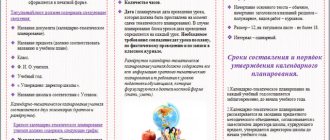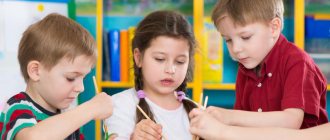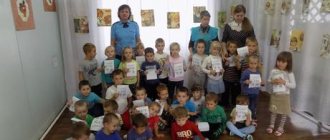Calendar and thematic planning (senior group)
Ekaterina Egazaryan
Calendar and thematic planning (senior group)
November. Topic : Health and Nutrition
Goal: to introduce children to the concept of
“proper nutrition”
,
“vitamins”
. Instill the need for healthy food.
MONDAY
12/07/2020 JOINT ACTIVITY OF ADULTS AND CHILDREN TAKEN INTO ACCOUNT OF INTEGRATION OF EDUCATIONAL AREAS
MODE GROUP , SUB-GROUP ACTIVITIES INDIVIDUAL ACTIVITIES EDUCATIONAL ACTIVITIES IN REGULAR MOMENTS
MORNING Independent games for children. Morning exercises.
Morning circle. Introduction to the day. Dialogue between the teacher and the children about the past weekend. Let's share our impressions.
Conversation: “ A healthy mind in a healthy body”
»Goal: explain the proverb.
D/game “Say it in one word”
Goal: learn to classify food products.
D/game “What for what?”
Goal: consolidate the names and sequence of the days of the week.
Situational conversation “What is health?”
OOD 9.00-9.25 Cognitive development (child in the outside world)
.
9.35-9.50 Artistic and aesthetic development (drawing)
12.00-12.25 Physical development (swimming 1 subgroup )
.
WALK Observation of the plant world. Purpose: to form the concept of the change of seasons; give an idea of the features of each season.
Labor activity.
P/game “Nimble Pedestrian”
Goal: learn to coordinate movements with each other; strengthen the ability to cross the road
D/game “Where is the nose, where is the ear”
Goal: to develop attention and the ability to focus on oneself.
Independent activity Conversation on the topic “Name spring natural phenomena”
Goal: to consolidate children’s knowledge about natural phenomena.
EVENING Health-improving gymnastics after a nap.
Evening circle. Discussion of interesting moments from the past day.
S/r game “Aibolit Hospital”
Goal: consolidate the use of healthy foods.
Learning “Products”
V. Nishchev Reading: Porridge from an ax Purpose: to teach listening carefully
Situational conversation: What I like to eat
WALK Observation Purpose: Offer to independently find signs of winter
P/game “Don’t run into a circle”
Goal: teach children to run while dodging
D/game “What is the name of the soup”
Goal: to activate the vocabulary, develop logical thinking. Fix the name of the soups:
“borscht”
(beetroot and tomato soup,
“rassolnik”
(cucumber soup),
“ukha”
(fish soup),
“shchi” (cabbage soup)
. D/ game
“Wonderful Bag”
Purpose: to teach children to recognize objects by their characteristic features Situational conversation
“Is tasty food always healthy?”
December. Topic: “Health and nutrition”
TUESDAY
12/08/2020 JOINT ACTIVITY OF ADULTS AND CHILDREN TAKEN INTO ACCOUNT OF INTEGRATION OF EDUCATIONAL AREAS
MODE GROUP , SUB-GROUP ACTIVITIES INDIVIDUAL ACTIVITIES EDUCATIONAL ACTIVITIES IN REGULAR MOMENTS
MORNING Independent games for children. Morning exercises.
Morning circle. Introduction to the day.
Conversation “Vitamins in human life”
Goal: to develop knowledge among students about the role of vitamins in human life; about what vitamins we can get from what food products.
D/game “Guess the sport”
Goal: to introduce children to sports; sports equipment; to develop children's interest in physical education and sports
D/game for REMP “What does it sound and how much?”
Goal: to practice ordinal counting of sounds D/game “Beneficial – Harmful”
Goal: identifying knowledge about healthy and unhealthy foods
Situational conversation “What do you know about yourself”
Consolidate knowledge about the purpose of certain organs (ears - to hear, eyes - to see, etc.)
.
OOD 09.00-9.25 Cognitive development (FEMP)
.
09.40-10.15 Artistic and aesthetic development (musical)
.
12.00-12.25 Physical development (swimming 2nd subgroup )
.
WALK Observation of the animal world: magpie Purpose: to stimulate interest in the “fairy-tale person”
- soro-ke-white-sided; teach to recognize a bird by its plumage and the sound it makes; enrich your vocabulary with artistic words; cultivate a caring attitude towards birds.
Labor activity.
P/game “From bump to bump”
Goal: learn to jump with a push of one or two legs, act according to the rules; cultivate friendliness.
D/game “Fourth wheel”
Goal: to develop logical thinking.
Independent activity Conversation on the topic “What are the benefits of milk”
EVENING Health-improving gymnastics after a nap.
Evening circle. Discussion of interesting moments from the past day.
S/r game “Healthy food store”
Goal: to consolidate students’ knowledge about healthy foods; develop volitional interaction, dialogical speech.
D/game according to traffic rules «»
Target:
Independent activity in play areas D/game “Cinderella”
Goal: to train children in the analysis of 2-3 types of cereals (peas, lentils, pearl barley, to develop fine motor skills of the hands. Situational conversation:
“We strive to have healthy eyes.”
Goal: To reveal the importance of vision for the perception of the world around us. To consolidate knowledge about the structure of the eye, the role of vitamins and alternative healing methods in improving vision
WALK Target walk «»
Target:
P/game Hunter and Hares «»
Goal: develop agility, speed
D/game “Describe familiar objects”
Goal: activation of the dictionary.
D/game “What first - what then (daily routine)
” Purpose: to reinforce the idea that following the correct daily routine is good for health. Develop the ability to coherently and consistently explain your actions.
Situational conversation “We want to be healthy!”
Goal: to develop healthy lifestyle skills in children related to their daily routine; ability to perform activities consistent with the daily routine
December. Topic : Health and Nutrition
WEDNESDAY
09.12.2020 JOINT ACTIVITY OF ADULTS AND CHILDREN TAKEN INTO ACCOUNT OF INTEGRATION OF EDUCATIONAL AREAS
MODE GROUP , SUB-GROUP ACTIVITIES INDIVIDUAL ACTIVITIES EDUCATIONAL ACTIVITIES IN REGULAR MOMENTS
MORNING Independent games for children. Morning exercises.
Morning circle. Creating a positive mood for the day.
S/r game "Construction"
.Goal: to form specific ideas about construction and its stages; consolidate knowledge about working professions; cultivate respect for the work of builders; develop the ability to creatively develop the plot of the game.
Conversation on life safety "Don't play with stray animals"
Goal: to explain to children that contact with animals can sometimes be dangerous; to teach them to take care of their safety.
D/game “Healthy and harmful foods”
Goal: to develop the sound culture of speech, systematize children’s ideas about harmful and healthy products, exercise the ability to differentiate them, and develop the need to take care of their health.
D/game “Keen Eye”
Purpose of the game: develop attention. Situational conversation “What is health?”
Goal: to consolidate the concept of “health”
; expand children's knowledge about preventive measures to prevent diseases and injuries; teach to make judgments based on your personal experience and the experience of other children and adults; We develop dialogical speech.
OOD 09.00-9.25 Speech development (literacy training)
.
16.00-16.25 Artistic and aesthetic development (musical)
WALK Observing the weather conditions Purpose: - compare the weather in the morning with the evening weather. Draw simple conclusions.
Labor activity.
P/game “We are funny guys”
Goal: to improve children’s motor skills.
D/game “What is made of what”
Purpose: to teach children to identify the material from which an object is made
Independent activity Conversation on the topic “The human body”
Purpose: To clarify children’s knowledge of what parts the human body consists of, to talk about the role of the senses.
EVENING Health-improving gymnastics after a nap.
Evening circle. Discussion of interesting moments from the past day.
S/r game "Polyclinic"
Goal: to learn to convey familiar situations in the game, to act as doctors, doctors, patients.
Morning work-out
D/game “Making a menu”
Goal: to form the idea that health depends on proper nutrition - food should not only be tasty, but also healthy
Games with building materials “Let’s build a house”
Goal: Compose houses of different sizes.
Teach children to select doors, windows, roofs that correspond to the size of a given house. D/game “What a Wind”
Goal: to teach how to select relative adjectives Situational conversation:
“Healthy foods.”
Goal: to develop children’s knowledge about healthy and unhealthy foods. Develop healthy eating principles.
WALK Game experimentation “Why does the snow melt?”
Goal: To establish the dependence of changes in nature on the season.
P/game “Crow and Sparrow”
Goal: continue to teach children to act on a signal and navigate in space.
D/game “Edible – inedible”
Goal: to form attention, develop the ability to highlight the main, essential features of objects D / game
“Health Labyrinths”
Goal: to consolidate knowledge about personal hygiene items and their purpose.
Situational conversation “Signs of winter”
Purpose: To generalize knowledge about winter changes in nature, in the life of birds and animals.
December. Topic : Health and Nutrition
THURSDAY
10.12.2
0 JOINT ACTIVITY OF ADULTS AND CHILDREN, CONSIDERING THE INTEGRATION OF EDUCATIONAL AREAS
MODE GROUP , SUB-GROUP ACTIVITIES INDIVIDUAL ACTIVITIES EDUCATIONAL ACTIVITIES IN REGULAR MOMENTS
MORNING Independent games for children. Morning exercises.
Morning circle. Introduction to the day. Creating a positive mood for the day.
Conversation: «»
Goal: to cultivate the moral qualities of the child’s personality
Game experimentation “The life-giving properties of water.
Purpose: to show the important property of water to give life to living things.
Guessing riddles on the topic “vegetables”
.
Articulatory gymnastics “Exercise for the tongue.”
Goal: development of the articulatory apparatus, mobility and plasticity Situational conversation
“Sport is health”
Goal: developing in children a conscious attitude towards their health and the need for a healthy lifestyle; accumulation and enrichment of children’s knowledge about the Olympics; improve knowledge about various sports.”
OOD 09.00.-9.25 Cognitive development (FEMP)
09.50-10.15 Artistic and aesthetic development (Drawing)
15.10-15.35 Physical development.
WALK Game experimentation “Colorful balls
Goal: to obtain new shades by mixing primary colors: orange, green, purple, blue.
Labor activity.
P/game " Planes"
Goal: to teach children to run in different directions without bumping into each other, to teach them to listen carefully to the signal and start moving.
D/game “Which is more useful?”
Goal: to consolidate children's knowledge about healthy and harmful products, and those that do not cause harm, but are not useful and necessary for human health.
Independent activity
Conversation “Safety on site”
.Goal: to create conditions for children to develop ideas about sources of potential danger on the playground, about the rules of safe behavior when walking.
EVENING Health-improving gymnastics after a nap.
Evening circle. Discussion of interesting moments from the past day.
S/r game "Zoo"
Goal: to expand children's knowledge about wild animals: to cultivate kindness, responsiveness, sensitive, attentive attitude towards animals, a culture of behavior in public places.
Dramatization game “Greasy Girl”
Target.
Teach children to create a plot from simple actions and involve them in active participation in the game. Cultivate the desire to always be clean. Reading M. Pototskaya “Acute pig disease”
. Purpose: Expanding ideas about the components of a healthy lifestyle.
Situational conversation “Germs and Viruses”
Goal: to consolidate ideas about the rules of personal hygiene, to give children a basic understanding of infectious diseases and their causative agents
(germs and viruses)
WALK Observation of changes in nature. Goal: To develop the skills to independently find signs of winter
P/game "Stop"
.Goal: to contribute to the improvement of game actions, to develop the ability to compare one’s actions with the rules of the game
D/game “Helpful-harmful”
Goal: to consolidate children’s knowledge about environmental factors.
environment affecting health. D/game “Find where it’s hidden”
Goal: to develop children’s ability to navigate in space, develop the ability to act as a leader, and come up with tasks for the game.
Situational conversation “About the benefits of vitamins, and why do people need them?”
Goal: to give children knowledge about the benefits of vitamins for our body.
December. Topic : Health and Nutrition
FRIDAY 12/11/20 JOINT ACTIVITY OF ADULTS AND CHILDREN, TAKEN INTO ACCOUNT OF INTEGRATION OF EDUCATIONAL AREAS
MODE GROUP , SUB-GROUP ACTIVITIES INDIVIDUAL ACTIVITIES EDUCATIONAL ACTIVITIES IN REGULAR MOMENTS
MORNING Independent games for children. Morning exercises.
Morning circle. Introduction to the day.
Conversation on life safety “What are bad habits?”
Goal: to consolidate the concept of
“health”
; expand children's knowledge about preventive measures to prevent diseases and injuries; teach to make judgments based on your personal experience and the experience of other children and adults; We develop dialogical speech.
D/game “Boys and Girls”
Goal: develop the ability to compare, generalize, speech, attention; develop curiosity
Teamwork «»
Goal: summarizing knowledge on the topic of the week.
D/game “What is missing”
Goal: to develop visual memory and attention.
Situational conversation “Where can I find vitamins?”
Purpose: To introduce the importance of vitamins and minerals in human life. Reinforce the concept of the benefits of fruits and vegetables. Foster a food culture.
OOD 09.00-909.00-9.25 Speech development.
9.35-10.00 Artistic and aesthetic development
WALK Observation of the work of adults Purpose:
Labor activity. “Cleaning up the area from debris.
Goal: to develop work skills and a sense of teamwork.
P/game “Two Frosts Goal. Continue to develop agility and reaction speed. Strengthen the ability to act according to the rules.
D/game “What has changed?”
.Tasks: exercise in determining the spatial arrangement of objects; develop observation skills, activate vocabulary” Goal:
Independent activity Conversation on the topic “Situational conversation. "Sport is health"
Goal: to develop in children a conscious attitude towards their health and the need for a healthy lifestyle; accumulation and enrichment of children’s knowledge about the Olympics; improve knowledge about various sports.
EVENING Health-improving gymnastics after a nap.
Evening circle. Discussion of interesting moments from the past day
S/r game "Photo Studio"
.Goal: to expand and consolidate children’s knowledge about working in a photo studio, to cultivate a culture of behavior in public places, respect, polite treatment of
elders and each other , to teach gratitude for the help and service provided.
D/game “Morning begins...”
: Goal: to teach children to follow a daily routine, to consolidate activities carried out at different times of the day.
Articulation gymnastics “Frog”
Purpose: to practice moving the lower lip down and into place. Develop
mobility and strengthen the muscles of the lips.
Situational conversation “About the benefits of vitamins, and why do people need them?”
Goal: to give children knowledge about the benefits of vitamins for our body.
WALK Observation of the clothes of adults and children. Purpose:
continue to develop the ability to establish simple connections between changes in and living, inanimate nature.
P/game “Wolf in the Moat”
Goal: to develop courage and dexterity, the ability to act on a signal.
D/game “Recognize and name vegetables”
.Goal: to consolidate the names of fruits and vegetables, to develop the ability to recognize them from the teacher’s description.
D/game “D/game Flies - doesn’t fly”
.
Goal: develop auditory attention. Situational conversation about “Harmful and healthy food”
Goal: to form an idea of the benefits and harms of certain products for human health
Plan of educational work in the senior group
Health-improving gymnastics after sleep. Breathing exercises. Walking along massage paths.Conversation “What’s the weather like outside” (children’s impressions of the weather, about the frosty morning)
Conversation on the topic “Winter is coming, it’s calling.”
With the help of the works of Russian poets, awaken in children interest and love for their native nature and Russian winter. Clarify children's knowledge about winter natural phenomena, teach them to talk about the phenomena described in poems.
Role-playing games: “Family”, “Bus trip to the winter forest”, “Family preparing for the New Year”, “Library”.
Continue work to develop and enrich the plots of games: expand children’s independence in choosing a role, developing and implementing a plan, develop the ability to select objects and attributes for the game, develop the ability of children to agree on what they will do.
Didactic games: “Say the opposite”, “Say it correctly”, “What’s for what?” “Fold a New Year’s card”, “When this happens.”
Develop attentiveness and observation, teach children to play following certain rules, train children in composing a whole object from its parts, and consolidate children’s knowledge about the seasons.
Educational game. “Whose trace?”
To clarify and consolidate children’s knowledge about wild animals and their way of life in the winter forest. To introduce the types of tracks of wild animals, to develop the ability to correlate the animal with the tracks it left in the winter forest. Develop logical thinking, imagination, coherent speech.
Theatricalization: dramatization of the fairy tale “Wintermovie”. Table theater: “Little Fox and the Wolf.”
Develop the ability to perform simple performances based on familiar literary works; use known expressive means (intonation, facial expressions, gestures) to embody the image.
Independent activity of children.
S/r games optional. Monitoring children's relationships, promoting a favorable psychological climate.
Cognitive, research and productive (constructive) activities.
Topic: “Properties of water.” Expand children's understanding that water in frost turns into ice, icicles, snow, and melts in a warm room. Introduce the life of animals and birds in the winter forest.
Independent activity of children.
Printed board games optional. Development of thinking, memory, attention, independence, perseverance.
Games with building material “Builder No. 3”, LEGO
Learn to think about and plan practical actions, reason, justify your idea.
Didactic game: “Prepare the bunny and the squirrel for winter”
Continue to acquaint children with changes in the color of the fur of forest animals with the arrival of winter, and find out the cause of this phenomenon.
"Frost patterns"
Continue teaching children to draw frosty patterns in the style of lace making. Create conditions for experimenting with paints to obtain different shades of blue. Improve your technique of drawing with the end of a brush. Develop a sense of form and composition.
Offer children paints and plasticine for children to do independently.
Develop creativity and hand motor skills.
Reading of the poem by V. Berestov: “Snowfall”, fairy tales “Wintermovie”, arr. I. Sokolova - Mikitova, S. Yesenina “Winter Sings and Calls”, Y. Akim “First Snow”.
Teach children to listen carefully, understand the meaning of what they read, and convey their attitude to the content of the work.
Listening to Tchaikovsky "Winter"
Household work: washing toys.
Discuss with the children the purpose of this work, teach them to outline a plan for joint actions, and distribute responsibilities for preparing the necessary equipment. Foster a work culture and respect for materials and tools.



